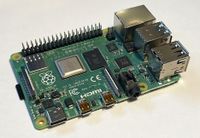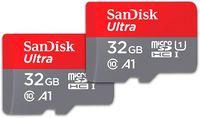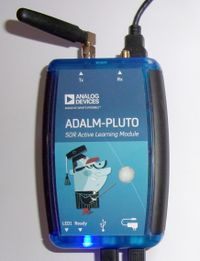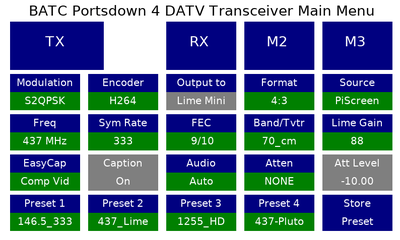Testing a HamTV Receiver using the Portsdown
The Portsdown 4 system can be set to transmit a near-HamTV specification signal from a Pluto SDR on boot-up.
Equipment Required
- Raspberry Pi 4 with 1, 2 or 4 GB of memory. Not any other Raspberry Pi version.
- A power supply for the Raspberry Pi.
- A fast MicroSD Card of 8 GB or more capacity. SanDisk Ultra UHS-1 card recommended (the red one).
- A genuine Analog Devices Pluto SDR with USB lead.
- A PC for use during the set-up phase, with a MicroSD card reader and a network and internet connection. The PC will need to be loaded with an SSH client such as KiTTY (free download from https://www.fosshub.com/KiTTY.html ) and a web browser.
- A wired network connection for the Raspberry Pi during setup.
Setup Activities
- Configure the Pluto
- Load the operating system on the SD Card
- Run the automated build script on the SD Card
- Use a web browser to configure the Portsdown software to the correct settings
After these steps, the Pluto will start transmitting a 2 MS DVB-S signal on 2395 MHz every time the system is started up.
Configuring the Pluto
The Pluto needs to have the frequency range extending (even though we are operating inside the designed frequency range), AND it needs special firmware to be loaded.
First install the Pluto Drivers on the PC. Download the .exe from here: https://github.com/analogdevicesinc/plutosdr-m2k-drivers-win/releases Run the .exe and when finished connect the Pluto to the PC by USB.
Once the Pluto has booted (it has an internal Linux processor) open the SSH Client (KiTTY). Connect to the Pluto by SSH at the IP address: 192.168.2.1. Accept the security alert.
login as user: root password: analog
For more details on the connection to Pluto see the article: https://f1atb.fr/sdr-adalm-pluto-setup/
To extend the frequency range, type the commands below:
fw_setenv attr_name compatible fw_setenv attr_val “ad9364”
Note that the more recent Revision C (outside label) (marked as Revision D on the PCB) Plutos need an extra environment variable setting for the frequency extension. In addition to the other commands, at the command line of the Pluto enter
fw_setenv compatible ad9364
You can check that the commands have been entered correctly by typing:
fw_printenv
At the end of the text produced, you should see something like this:
attr_name=compatible attr_val=ad9364 fit_size=1AB13A3 hostname=pluto ipaddr=192.168.2.1 ipaddr_host=192.168.2.10 netmask=255.255.255.0 xo_correction=40000001 udc_handle_suspend=0 netmask_eth=255.255.255.0 gateway_eth=192.168.0.254
Then type
reboot
The Pluto will disconnect from the PC and reconnect with the new settings.
The special firmware is F5OEO's "for the brave" Pluto firmware (FIRM2101RC of 5 February 2020). Extract the firmware from this zip file File:FIRM2101RC.zip. Then follow the instructions on this web page VERY CAREFULLY Analog Devices Firmware Upgrade Instructions.
You can check that you have the correct Firmware loaded by logging into the Pluto again by ssh. The first line after the Pluto logo should read v0.31-4-g9ceb-dirty
Now disconnect the Pluto from your PC.
Loading the Operating System on the SD Card
The Portsdown 4 uses an older version of the operating system than is currently supported by the Raspberry Pi foundation. This is because the Portsdown software makes use of (video encoding) features that have been removed from more recent versions of the software.
First, download the 2023-05-03 release of Raspberry Pi OS Lite (Legacy, Buster) on to your PC from here https://downloads.raspberrypi.org/raspios_oldstable_lite_armhf/images/raspios_oldstable_lite_armhf-2023-05-03/2023-05-03-raspios-buster-armhf-lite.img.xz
Then, unzip the image (using 7zip as it is a .xz compressed file).
Download the Raspberry Pi Imager from here: https://www.raspberrypi.com/software/
Insert your SD Card into a card reader and connect it to the PC, Then open the Raspberry Pi Imager and accept the security warning.
Click Choose Device. Select Raspberry Pi 4 Click Choose OS. Scroll down to "Use custom", click and then browse to the image file that you just unzipped (2023-05-03-raspios-buster-armhf-lite.img). Open it. Click Choose Storage. Select your SD card. Click Next. On the OS Customisation screen, select Edit Settings. In the General tab, tick "Set username and password". Enter the username "pi", and the password "raspberry". In the Services Tab, tick Enable SSH and seelct "Use password authentication". Then click SAVE. On the OS Customisation screen (again), select YES. At the warning, select YES.
The SD card will take a few minutes to build and verify. If asked about formatting by your PC, DO NOT FORMAT the card.
Running the Build Script
Put the card into the Raspberry Pi 4, connect the LAN and the Power Supply. Turn on the Power, and let the Raspberry pi boot-up. It will restart at least once on this first occasion.
The first task is to determine the IP address of the Raspberry Pi on oyur LAN. You can use an application like Fing on your smartphone, or the PC program such as Advanced IP Scanner http://filehippo.com/download_advanced_ip_scanner/
Make a note of the IP address and connect to it using KiTTY or your SSH application. The username is pi and the password is raspberry.
Cut and paste the following commands in, one line at a time
wget https://raw.githubusercontent.com/BritishAmateurTelevisionClub/portsdown4/master/install_portsdown.sh chmod +x install_portsdown.sh ./install_portsdown.sh
The initial build can take between 45 minutes and one hour, however it does not need any user input, so go and make a cup of coffee. When the build is finished the Pi will reboot.
When the build has finished, put the Raspberry Pi's IP address into a browser on the PC like this:
http://192.168.0.237
The actual numbers will be different in every case. You should get a screen like this:
Configuring for automatic transmission on 2395 MHz
First, connect the Pluto SDR. Then, using the mouse to press the buttons, make the following selections:
Modulation: DVB-S QPSK
Encoder: H264
Output to: Pluto
Format: 4:3
Source: Test card
Freq: 2395 MHz. Use thwe Keyboard button, press clear, then 2395, enter.
Sym Rate: 2000
FEC: 1/2
Store Preset (goes red), Preset 1, New Label, press clear, HAMTV 2395 enter
M3 (brings up the Configuration Menu), System Config, Start-up App, Boot to Transmit, Exit



